Exercise Talisman Sabre is a bilateral, biennial combined major training exercise between Australia and the United States.
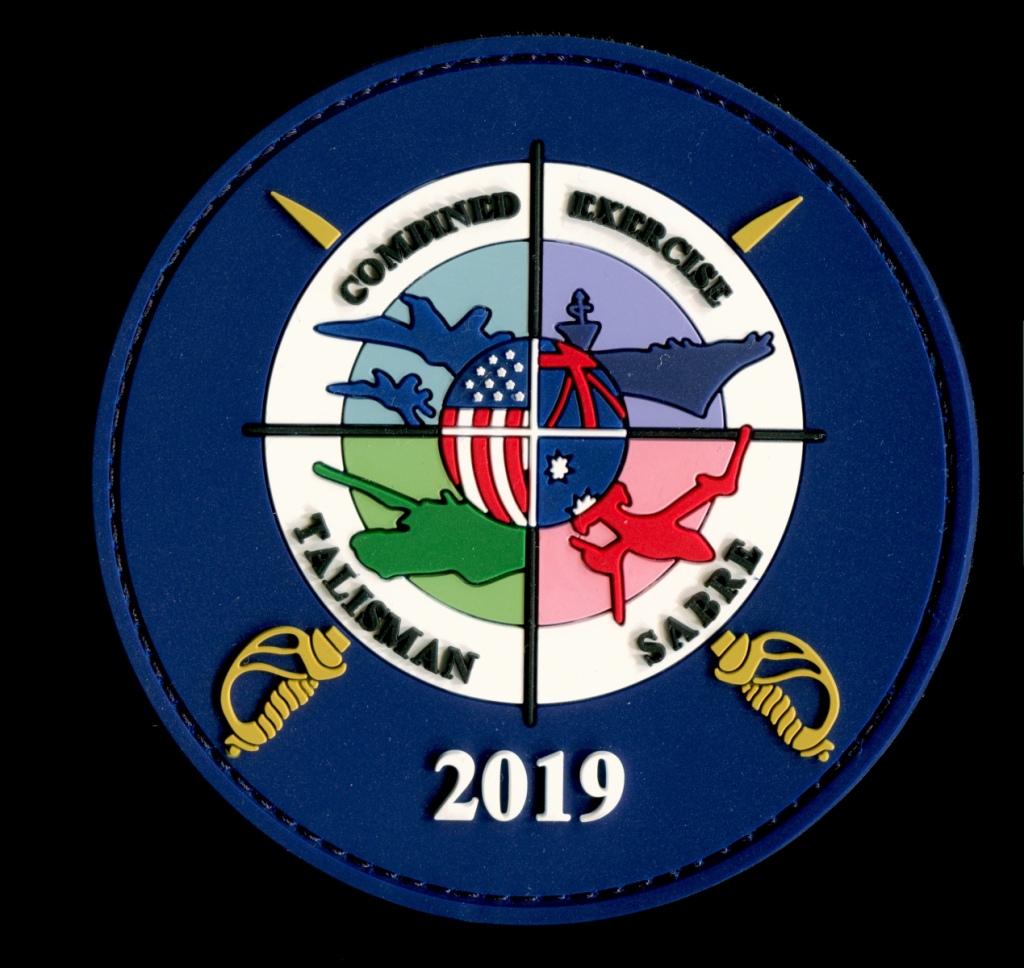
Talisman Sabre 2019 patch
The aim of the exercise is to strengthen the resolve between the military services of Australia and the United States, through combined and Joint Task Force operations, resulting in improved combat readiness and interoperability. Historically, Exercise Talisman Sabre is conducted throughout the Northern and Eastern regions of Australia, and within Australia’s Exclusive Economic Zone. This series of exercises is focused on planning and conducting, ‘high end’ mid-intensity warfare.
Talisman Sabre 2019 (TS19) is taking place in and around the ADF Shoalwater Bay Training Area (SWBTA), plus surrounding state forests, situated close to the township of Rockhampton in Central Queensland. Other areas used for training purposes include Strange Bay and the Capricorn Coast, including surrounding townships, the ADF Townsville Field Training Area (TFTA), plus the Evans Head Air Weapons Range (EVDAWR).
Conducted from late June until early August, TS19 also involves additional participants from third party nations, such as New Zealand, or are involved only as observers upon invitation. As the breadth and scale of Exercise Talisman Sabre covers such a wide expanse of area along Australia’s east coast, TS19 consists of Field Training Exercises that include force preparation activities, amphibious landings, land force manoeuvres, urban, air and maritime operations including activities conducted by the Special Forces.
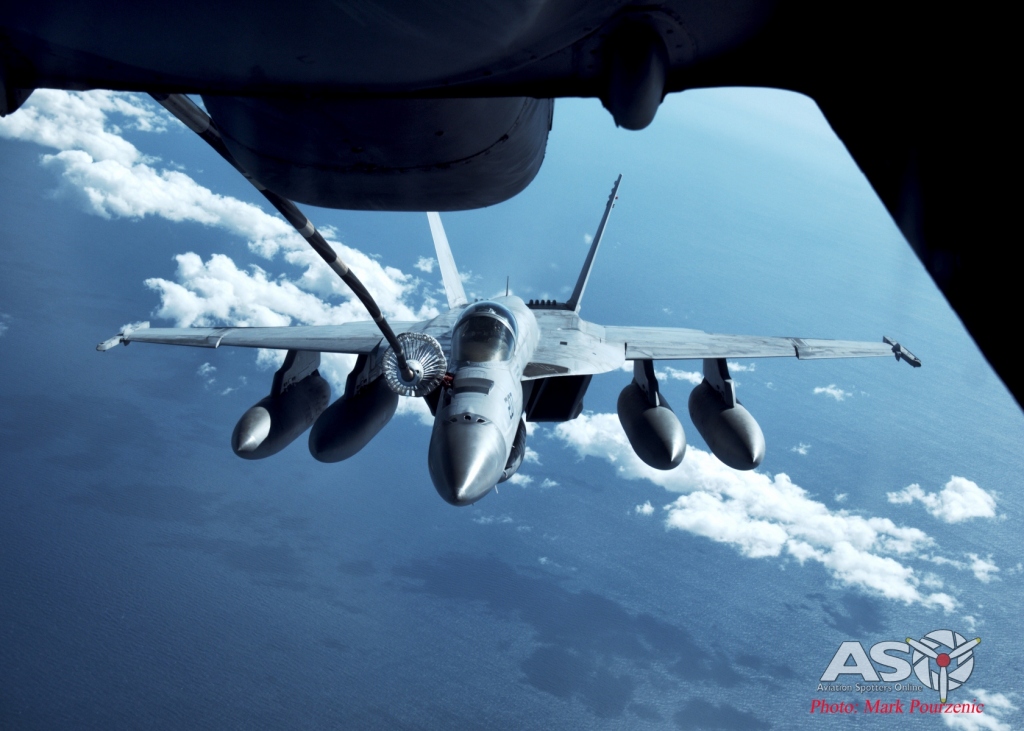
U.S Navy Boeing F/A-18E Super Hornet from VFA-27 ‘Royal Maces’ is seen taking on fuel during TS19
To reflect the bilateral nature of the exercise, leadership switches between Australia and the United States every two years, hence the difference in the spelling from Sabre -Saber. Talisman Sabre 2019 is the eighth iteration of the exercise since its inception back in 2005.

MDD KC-10A Extender 84-0188, 305thAMW/514thAMW (Associate)
During this years exercise, Aviation Spotters Online was privileged to have been offered a media flight onboard an United States Air Force, McDonnell Douglas KC-10A Extender, tail number 84-0188 from the 305th Air Mobility Wing (305thAMW), that resides at McGuire Air Force Base, New Jersey. The crew of four ( Aircraft Commander, Pilot, Flight Engineer) for this flight were from the 6th Air Refueling Squadron (6thARS), with the Boom Operator from the (9thARS), which operate under the umbrella of the 60th Air Mobility Wing (60thAMW), whom are home based at Travis Air Force Base in California, and have been operating out of Brisbane Airport for the duration of Exercise Talisman Sabre.
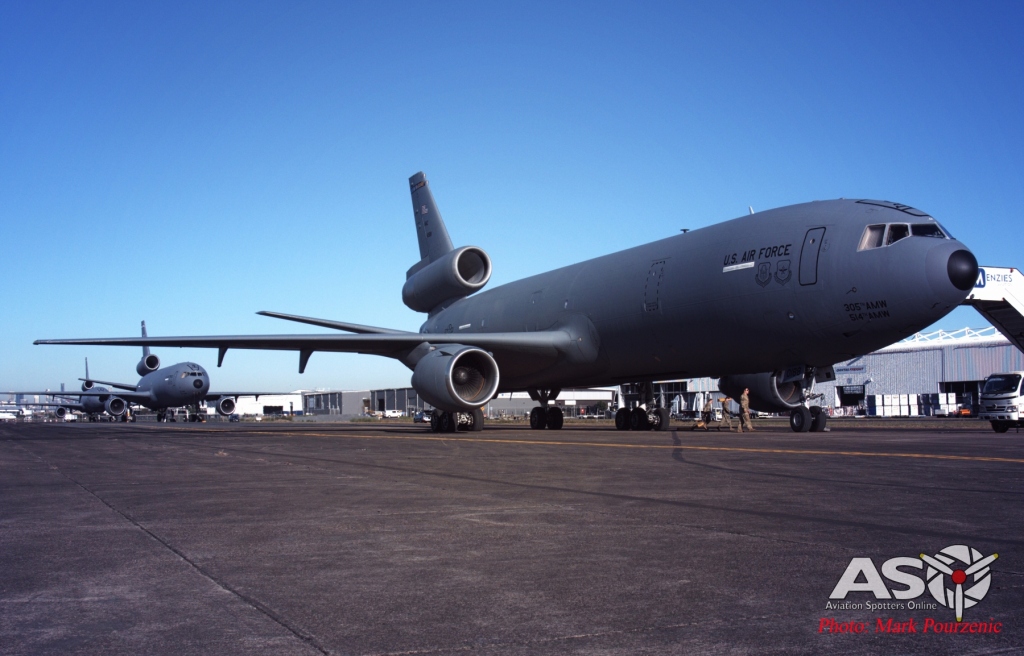
Three KC-10’s that are taking part in Exercise Talisman Sabre 2019 at their Brisbane Airport Base.
McDonnell Douglas KC-10A Extender
The McDonnell Douglas KC-10A Extender advanced tanker/cargo aircraft, is a descendant of the famed DC-10 series of intercontinental, wide body, three engine airliner, which first flew during 1971. Developed from the Advanced Tanker Cargo Aircraft Program, the design of the KC-10 involved modifications from the DC-10-30CF (Convertible Freighter), and took to the air for the first time on July 12 1980, with the aircraft performing its first aerial refueling sortie in October of the same year. With this design, the KC-10 shares an 88% commonality with its commercial counterpart, which gives it greater access within the commercial spares/support network.
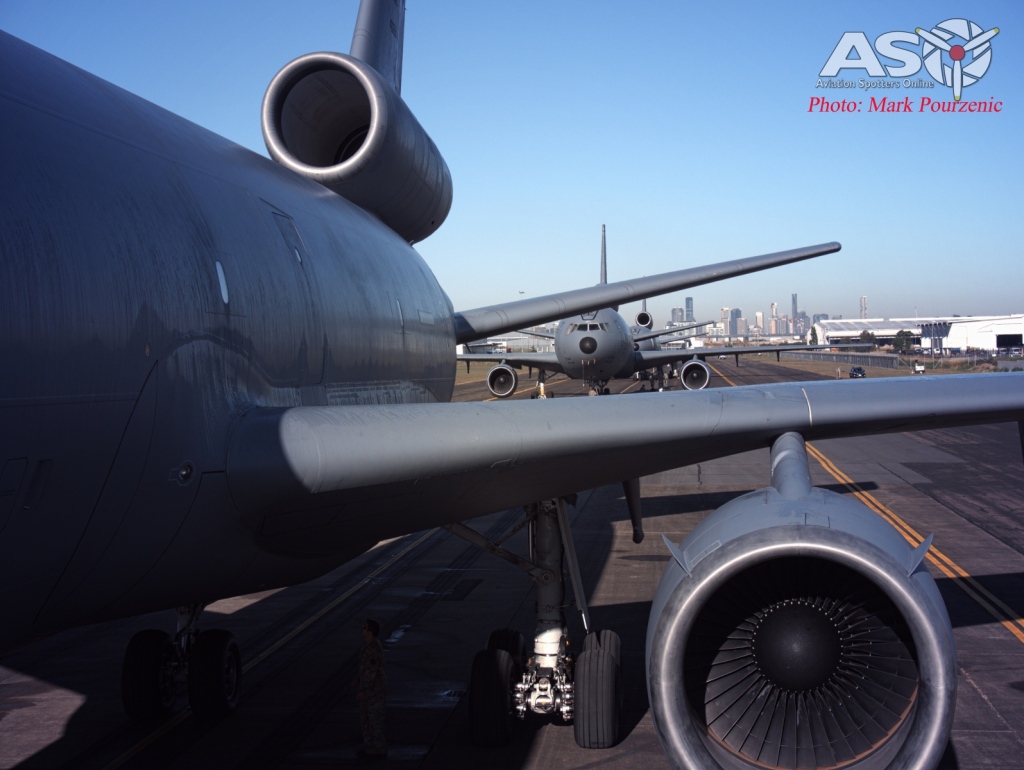
The KC-10A runs three F103 General Electric CF6-50C2 Turbofans, each producing 23,814kg of thrust, which enable the aircraft a gross take-off weight of up to 267,619kg and a max speed of 996km/h (0.89 mach).
The name ‘Extender‘ stems from the KC-10’s ability to forward deploy without basing, whilst carrying out its mission of cargo transport and aerial refueling, thus giving further reach to U.S Forces. The United States Air Force accepted the KC-10 into service in 1981 with the then, Strategic Air Command (SAC), at Barksdale Air Force Base in Louisiana, with the 60th, and final aircraft being delivered on the 29th November 1988. The year 1992 witnessed the KC-10’s leave SAC for the newly established Air Mobility Command (AMC), with the aircraft being primarily based at Travis Air Force Base in California, and Joint Base McGuire-Dix-Lakehurst, formerly known as McGuire AFB, New Jersey.
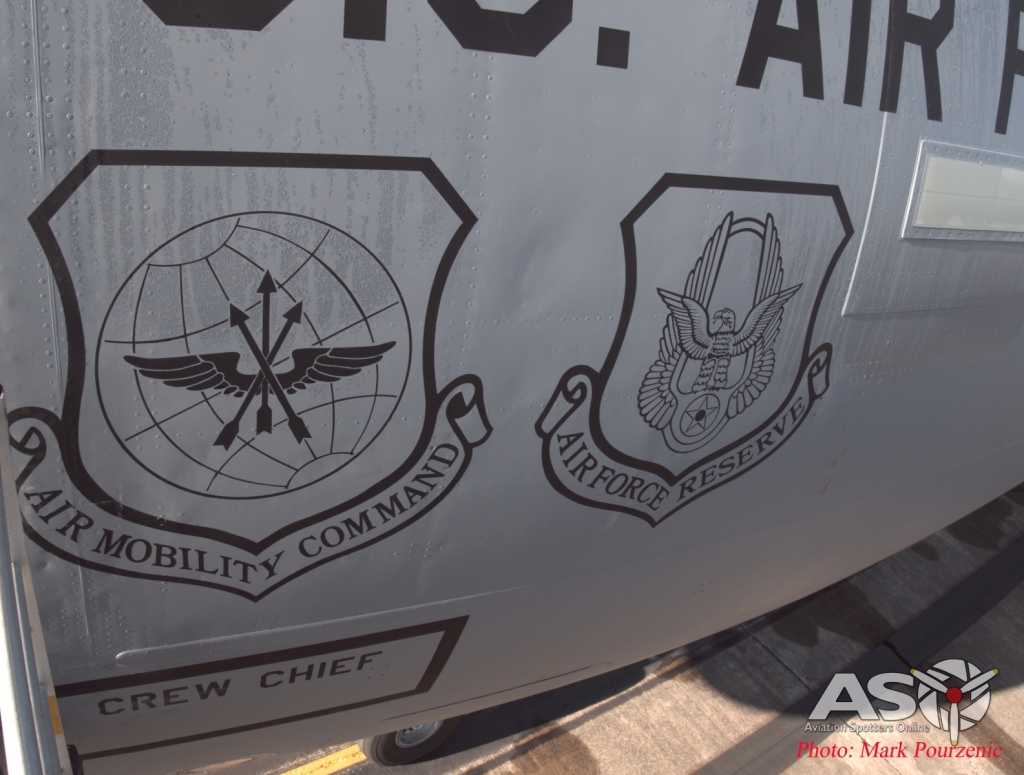
Air Mobility Command crest.
The more notable changes externally between the DC & KC-10 was the removal of most windows and lower cargo hold doors, plus the addition of the McDonnell Douglas Advanced Aerial Refueling Boom (AARB), which also necessitated in additional fuel tanks added in the lower baggage compartments below the main deck, that increased the KC-10’s fuel capacity to 161,478kg or 161 tonnes, which is almost double to that of the USAF Boeing KC-135 Stratotanker.

The view from inside the KC-10A Extender at Brisbane Airport.
The KC-10 has a unique centreline refueling boom with a control surface system located at the aft of the boom, which differs from previous types in service, including a drogue and hose system located on the starboard side of the rear fuselage, with the boom operator operating this digital fly-by-wire system from his location at the rear of the aircraft. Along with this probe and drogue system, the final twenty KC-10 aircraft produced where fitted with wing mounted pods, to further enhance its refueling capability. This unique system allows the Extender to refuel U.S Navy, Marine Corps, and most Allied aircraft in one mission, as was seen during Talisman Sabre 2019.
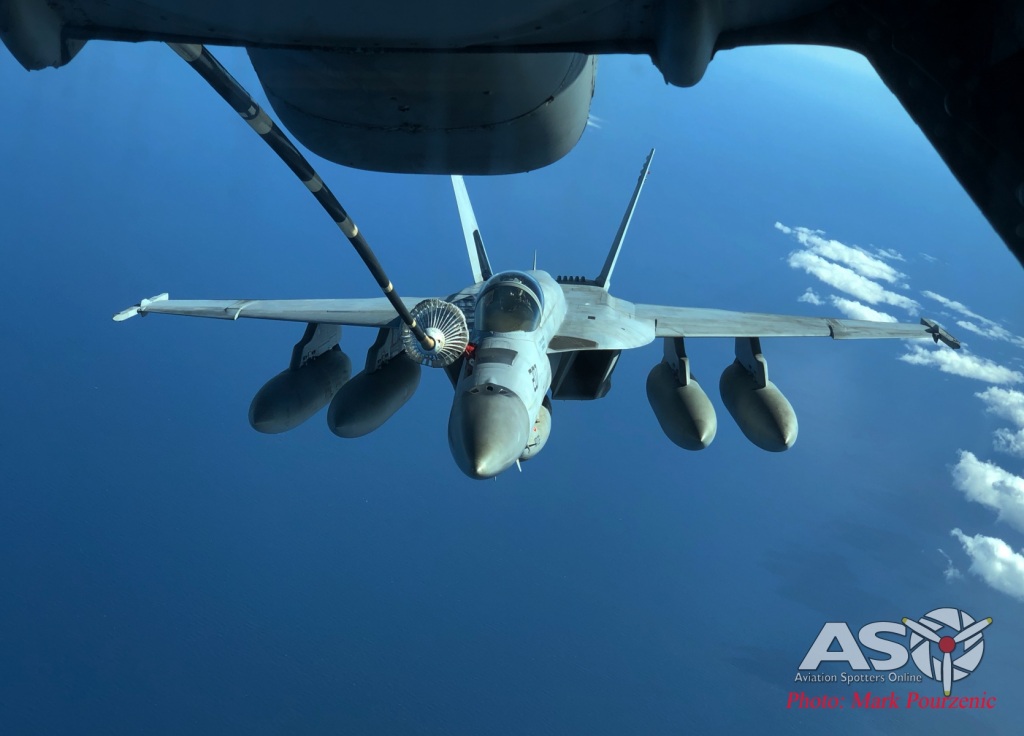
F/A-18E Super Hornet of VFA-27 ‘Royal Maces’ showing the ‘Hose and Drogue’ to good effect from the boomers position during a Talisman Sabre 2019 sortie.
During boom refueling operations, fuel is transferred to the receiver at a rate of 4,180 litres per minute, whilst the maximum rate via hose and drogue is 1,786 litres per minute that is drawn from its total fuel load of 161,508kg, including a maximum of 108,211kg stored in the standard wing tanks, plus the 53,297kg within the seven fuel cells below the main decks. The KC-10A has the ability to deliver over 90,000kg of fuel to a receiver well over 3,500km’s from its home base and return, or similarly, can carry 75 passengers, plus a maximum cargo load of over 76,000kg, a distance of 7031km. It’s unrefueled ferry range is a staggering 18,503km’s, with the KC-10 being able to receive fuel from KC-135 and KC-10 in-flight to further increase its range and reach.
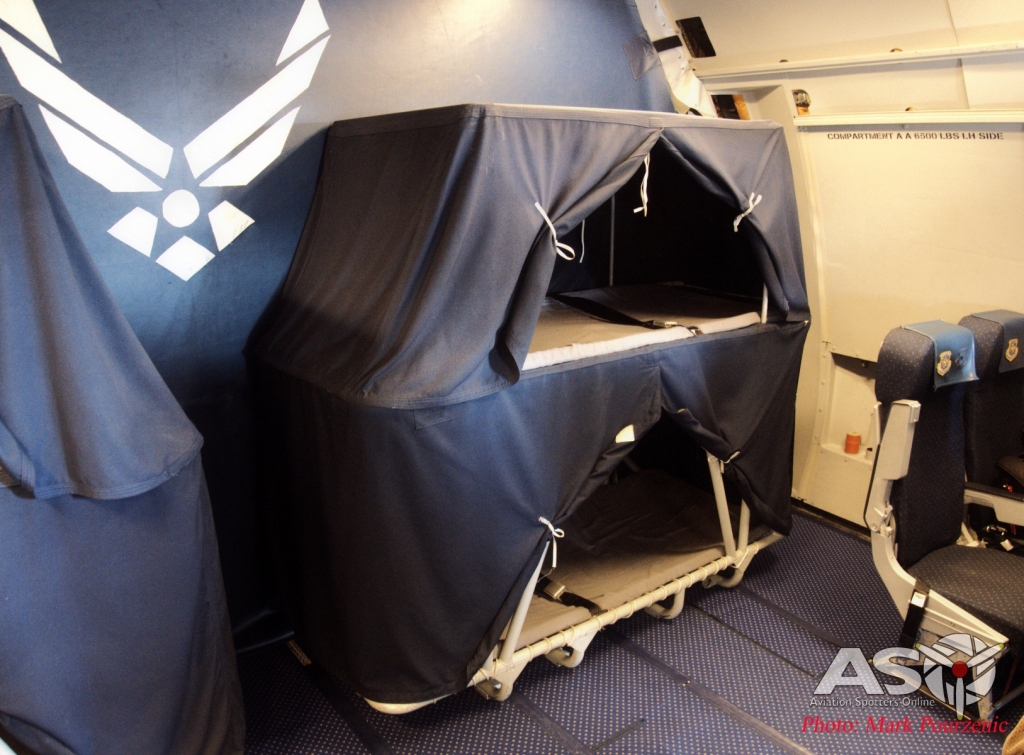
The view inside the forward crew accommodation area showing the double bunks, and the environmental curtain separating the cargo hold.
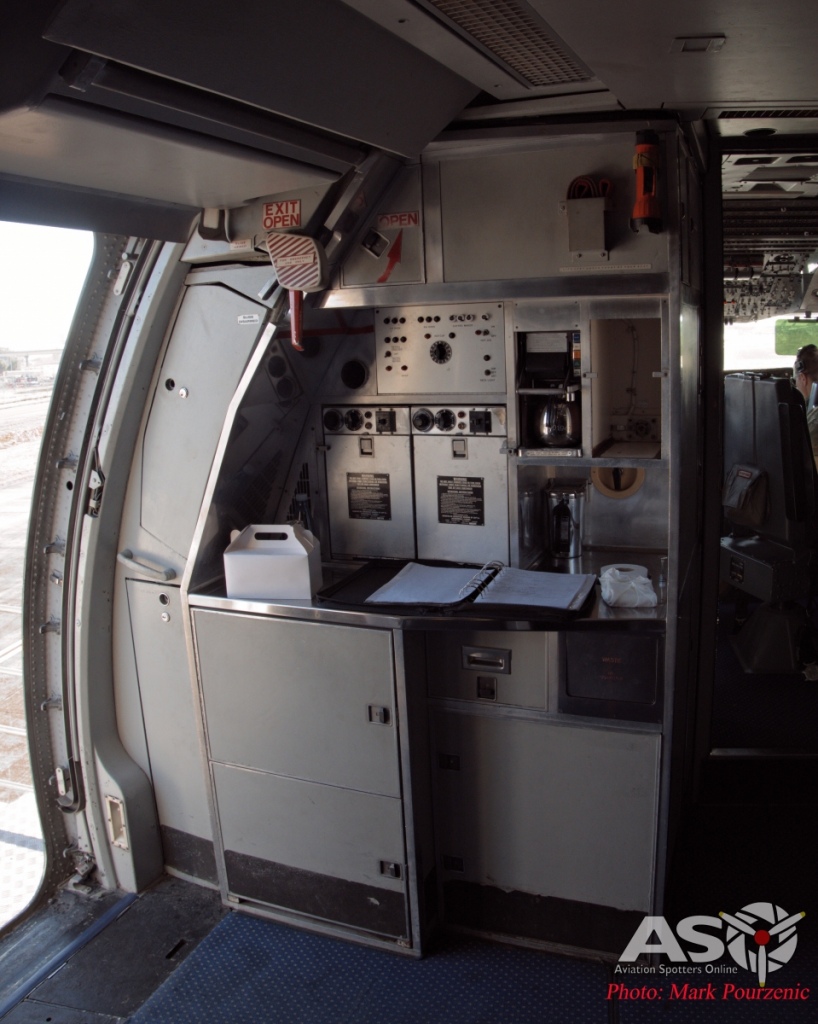
Galley area for crew refreshments

Port side seating arrangements, including oxygen and communications suite.
6th Air Refueling Squadron-
The 6th Air Refueling Squadron (6thARS) operates the McDonnell Douglas KC-10A Extender aircraft, providing mobility and air refueling missions, as part of the 60th Air Mobility Wing (60thAMW), at Travis Air Force Base in California.
The Squadrons story begins in January of 1940, when it was activated as the 6th Bombardment Squadron at Langley Field,Virginia. It’s need arose as the United States Army Air Force (USAAF) at the time was arming up after the break out of war in Europe. The Squadron was quickly relocated to McDill Field in Florida with a mix of B-17 Flying Fortresses, and Douglas B-18 Bolos. The unit was put into action following the Japanese attack on Pearl Harbour, with their immediate role to protect the Gulf of Mexico in the anti-submarine role. Towards the end of 1942, the threat of submarines in the area diminished and the need for the squadron followed suit, with the 6th Bombardment Squadron relocating to Gowen Field, Idaho, to become an Operational training Unit (OTU).
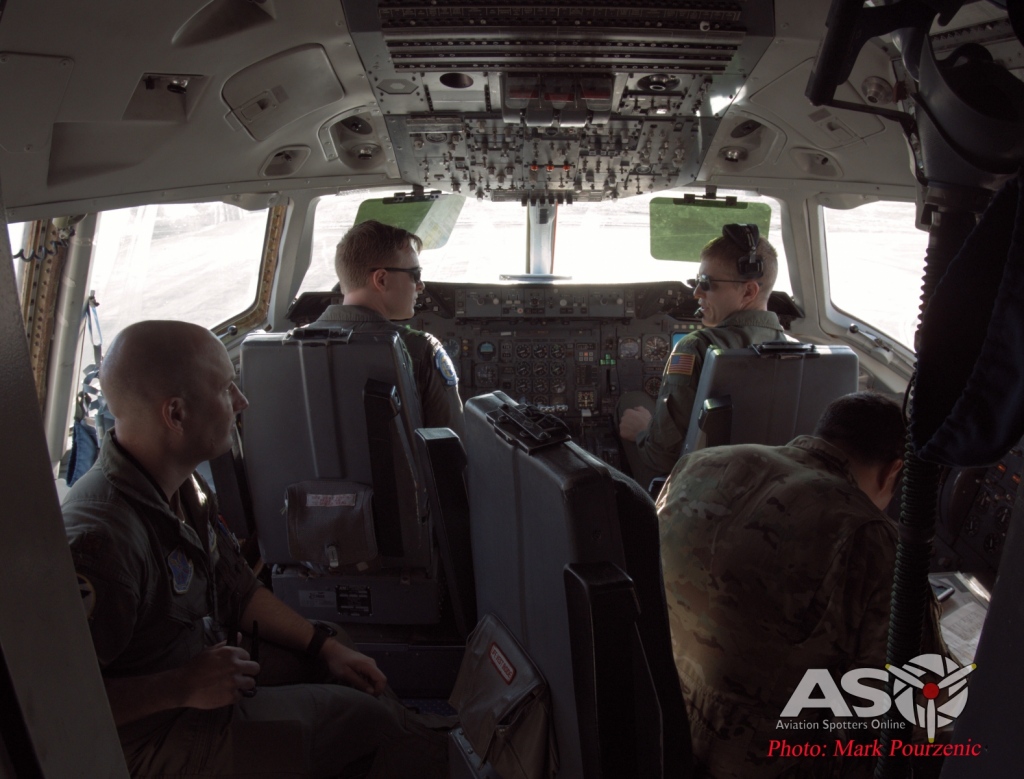
Aircrew of the 6th Aerial Refueling Squadron.
1943 saw the 6thBS exchange their B-17’s for Consolidated B-24 Liberators, and their role was to change yet again from an OTU, to a Replacement Training Unit (RTU), basically having them train individual pilots and aircrews. This scenario was short lived as by April 1st 1944, the squadron was inactivated as the Army Air Force were setting about combining fellow units and personnel into the newly formed Combat Crew Training School-Heavy, that fell under the 212th Army Air Force (AAF) Base Unit at Gowen Field. The same day, the Squadron was reactivated at Pratt Army Air Field, Kansas, flying the B-17 Flying Fortress before transitioning to the Boeing B-29 Superfortress.
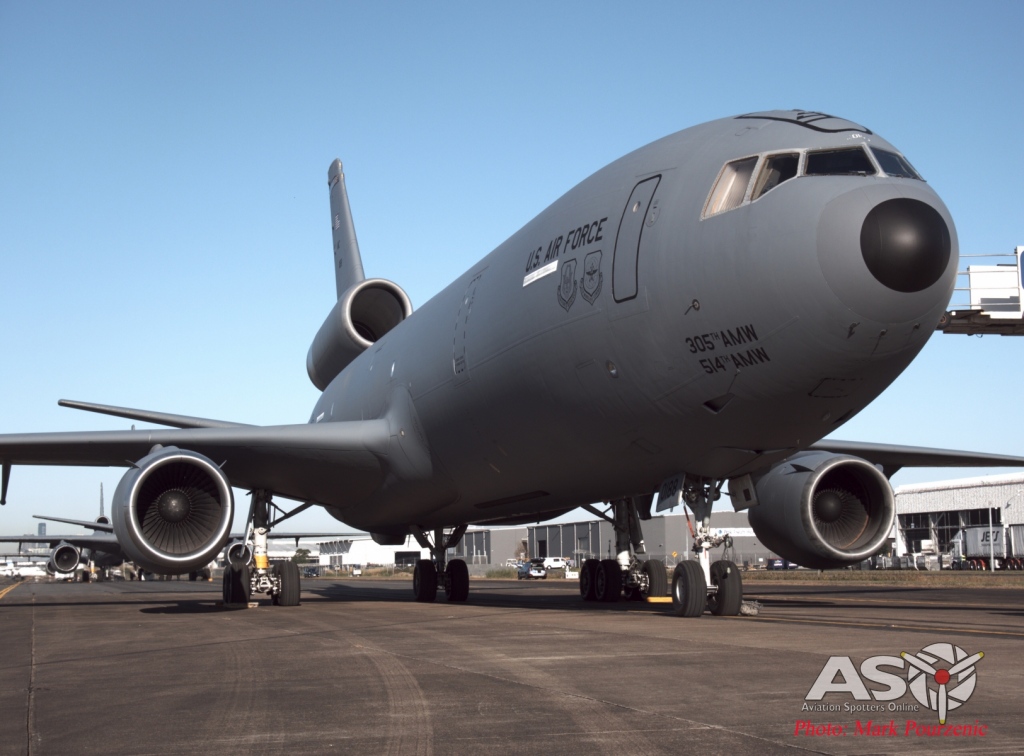
MDD KC-10A Extender 84-0188 seen at Brisbane Airport, July 24 2019.
Once the Squadron had trained up on the B-29 Superfortress, they deployed to North Field, Guam, where they became a component of the 314th Bombardment Wing of XXI Bomber Command. The Squadrons first combat mission was to attack Tokyo in February of 1945, with their missions in the beginning being that of high altitude attacks against strategic targets, progressing to low altitude night raids,using incendiaries in the final push towards the surrender of Japan, and saw the Squadron disband once again in Guam during March 1946.
The intervening years between 1947 saw the squadron fall under the Air Force Reserve at Barksdale Field, Louisiana, before inactivation in 1949. The 6th Air Refueling Squadron was activated during April 1951 at Walker Air Force Base, New Mexico, to begin training with the Boeing KB-29 tanker version of the Superfortress.

The expansive view through the boomers window situated at the rear of he KC-10A Extender
The Squadrons tenure with the 6thBG was relatively short, as the group was in the process of converting to the Convair B-36 Peacemaker which lacked any air refueling capability, requiring the Squadron inactive yet again. During 1957, the 6th Bombardment Wing had transitioned to the Boeing B-52B Stratofortress, that necessitated the need for air refueling aircraft, activating the 6th Air Refueling Squadron once again at Bergstrom Air Force Base, Texas during the latter half of 1957. This came after SAC had realigned its 27th Strategic Fighter Wing (27thFW) over to the Tactical Air Command (TAC), relinquishing its fighter aircraft, as the need for fast jet fighter bomber escorts were deemed unnecessary with the introduction of the Boeing B-47 and B-52 jet engine bombers, whilst retaining the 27th’s Air Refueling Squadron that was absorbed into the 6thARS.
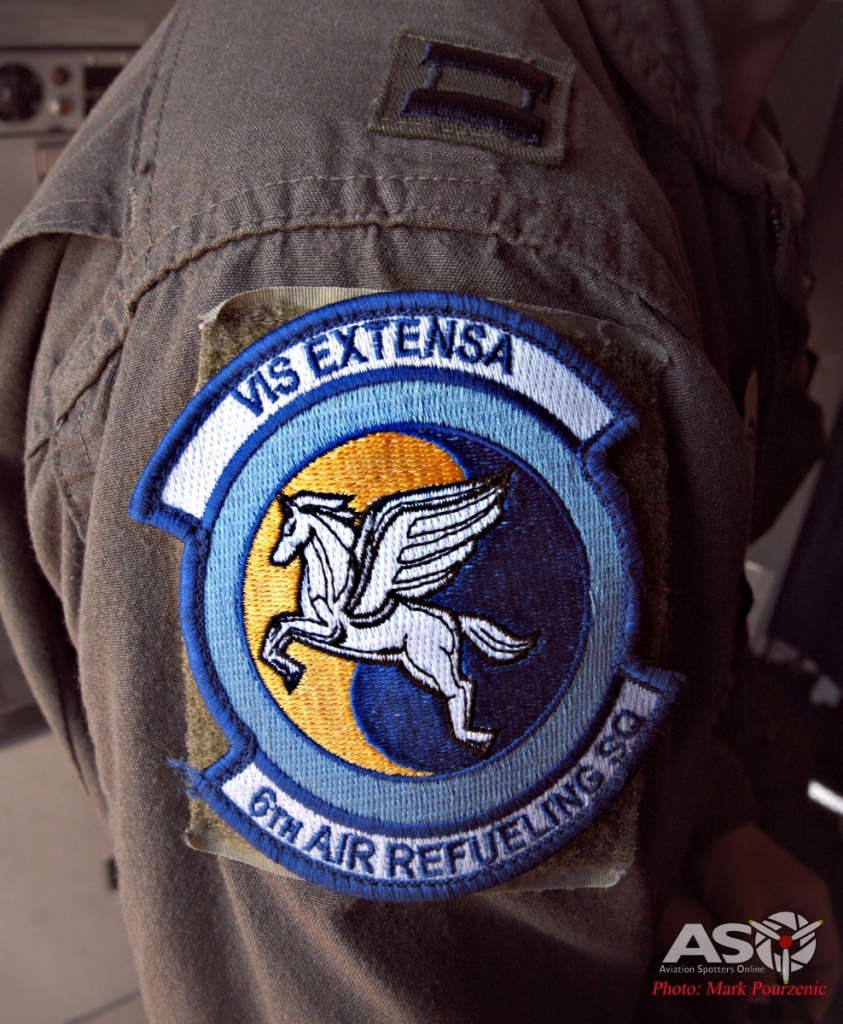
Current 6th Air Refueling Squadron patch ‘Vis Extensa’ – Strength Extended.
January 1958 had the Squadron return to Walker AFB, with the 6th Wing now flying the new Boeing KC-135 Stratotanker. Whilst at Walker AFB, the 6th was responsible for combat crew training on the KC-135 aircraft, and also maintained an around the clock alert status, as was seen during the Cuban Missile Crisis, when SAC was officially at DEFCON 2, and support of tactical operations in South East Asia. By December 1965, when the first Boeing B-52B Stratofortresses where starting to be phased from operational use, this reduction in activities also resulted in the inactivation of the 6th Wing and 6thARS at Walker Air Force Base, with the base being permanently closed in 1967.

An VFA-27 F/A-18E Super Hornet carrying external fuel tanks, as this aircraft acts as the Carrier Air Wings flying tanker during recovery operations, orbiting if any aircraft is in need of fuel to help it get back ‘on deck’.
September 18 1985 saw the 6th Air refueling Squadron consolidated with the 6th Bombardment Squadron, and activated at March Air Force Base, California during 1989 as a McDonnell Douglas KC-10A Extender unit assigned to the 22nd Air Refueling Wing (22ARW). During this time the Squadron was enjoying flying Worldwide air refueling missions, including deployment to the Persian Gulf during the Gulf War of 1990/91.
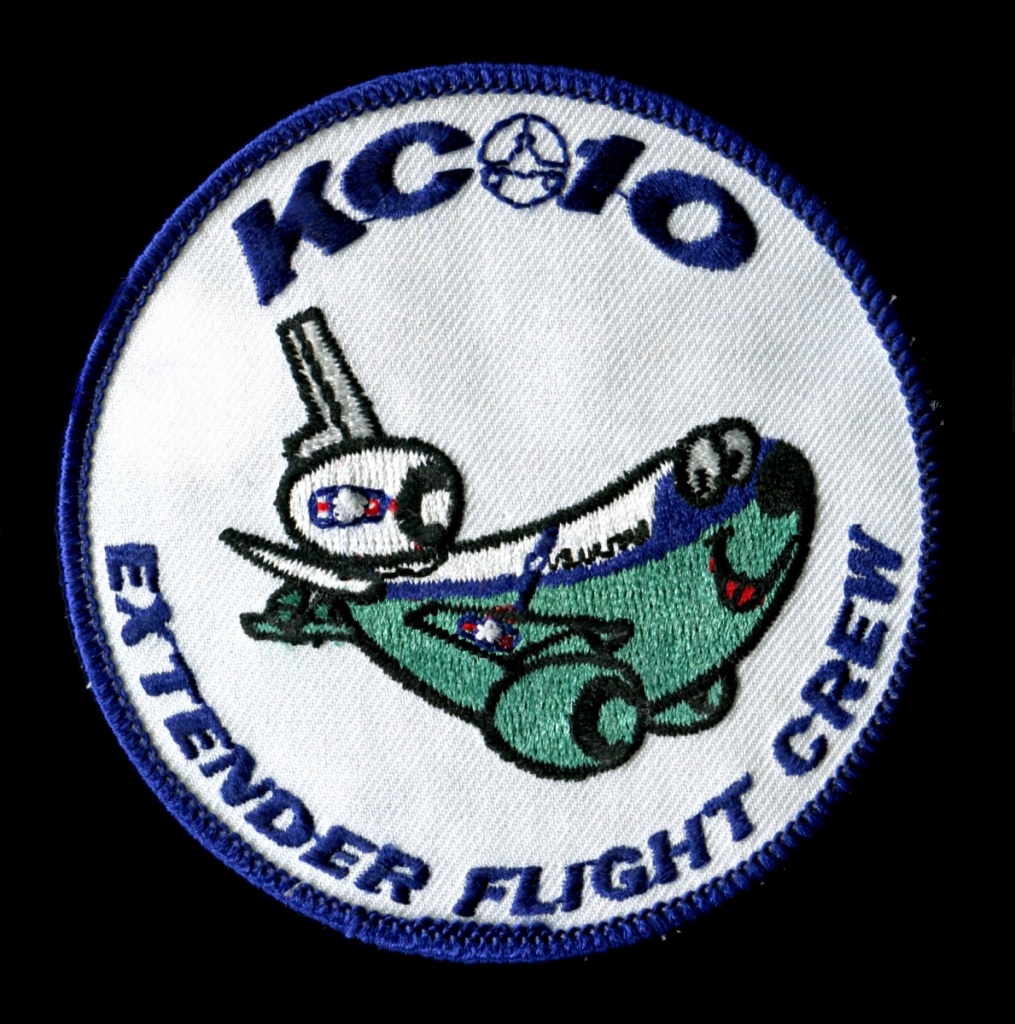
1980’s era Extender Flight Crew Embroidered Patch
The 6th Air Refueling Squadron were part of a contingent of 43 KC-10 Extenders deployed to the Gulf that routinely conducted round the clock operations, supporting all aspects of the air war, putting into use their methods of simultaneous boom and drogue refueling capability. Along with their capacity to refuel, the KC-10’s were utilised for their widebody design which allowed movement of critical cargo loads in support of other USAF assets such as the B-52, RC-135 Rivet Joint and U-2 during the air campaign. By the end of hostilities in the Gulf, U.S tankers combined, flew 14,000 sorties, which had them off load a staggering 725 million pounds ( 328,854,468.25 Kg), of fuel to roughly 50,000 receiving aircraft.
McDonnell Douglas KC-10A Extender 79-1950 from the 60thAMW, is seen arriving for Aviation Nation 2016 at Nellis Air Force Base, Nevada.
June 1992 had the United States Air Force re-organise its major commands, which involved the transfer of the 22ndWing to the newly formed Air Mobility Command, which combined elements from Airlift and Air Refueling under a single command. During 1991 the Base Realignment and Closure Commission had March Air Force Base transferred over to Air Force Reserve Command. This resulted in the 22nd Wing move to McConnell Air Force Base, Kansas in January 1994.
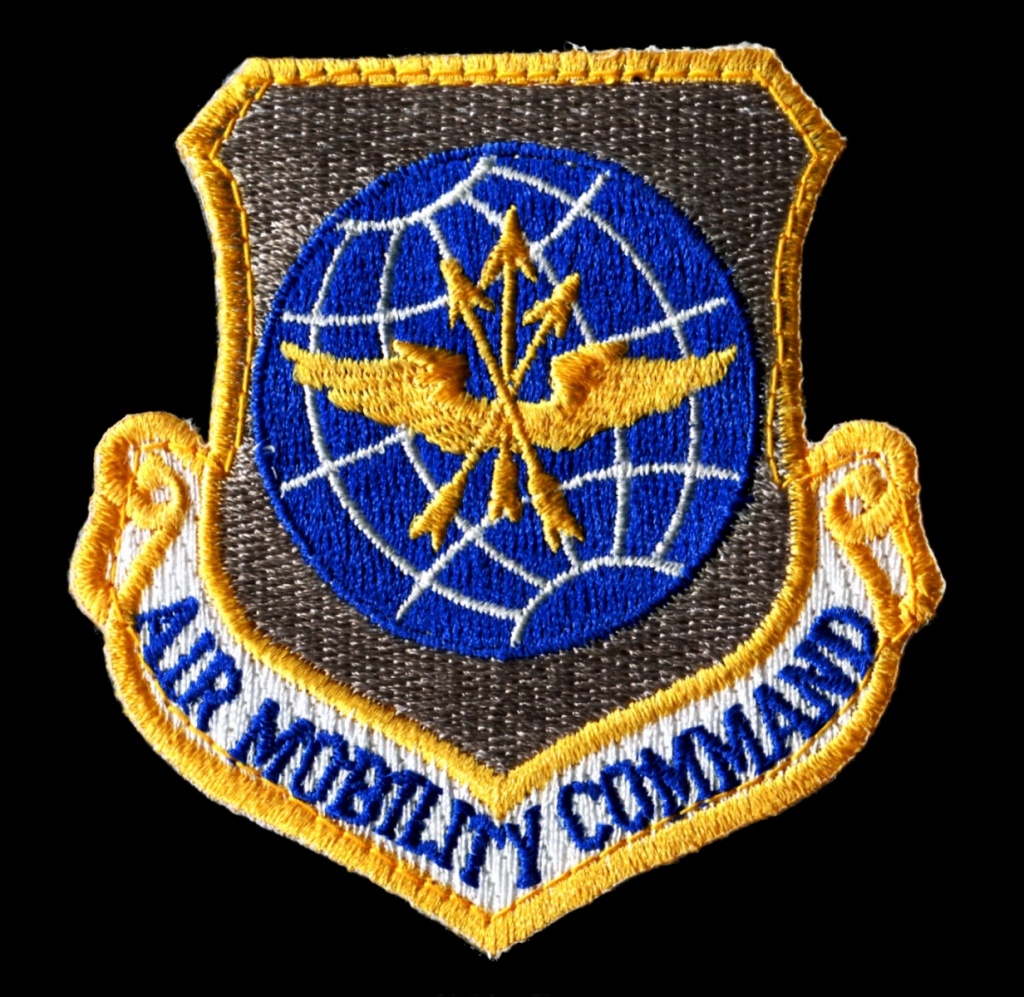
Air Mobility Command embroidered patch.
The 6th Air Refueling Squadron(6thARS) remained at March Air Force Base until August 1995, when it moved to Travis Air Force Base in California, where it became part of the 60th Air Mobility Wing (60thAMW).
60th Air Mobility Wing –
Located at Travis Air Force Base, California, the 60th Air Mobility Wing is the largest air mobility organisation within the United States Air Force in terms of personnel, that includes a versatile all jet fleet. As the host unit of Travis AFB, the Wing handles more cargo and passengers than any other military terminal within the continental United States.
With its motto of being ‘America’s First Choice’ for providing global reach, the crews of the 60thAMW fulfill this mission by flying support missions anywhere in the world, with particular focus on the Pacific and Indian Ocean areas of operation, that may also include Alaska and Antarctica. As part of Air Mobility Command, the primary role of the 60thAMW is of strategic airlift and air refueling, coupled with providing rapid, reliable airlift to American forces anywhere on the planet, supporting national objectives and extending the reach of air power via mid-air aerial refueling.
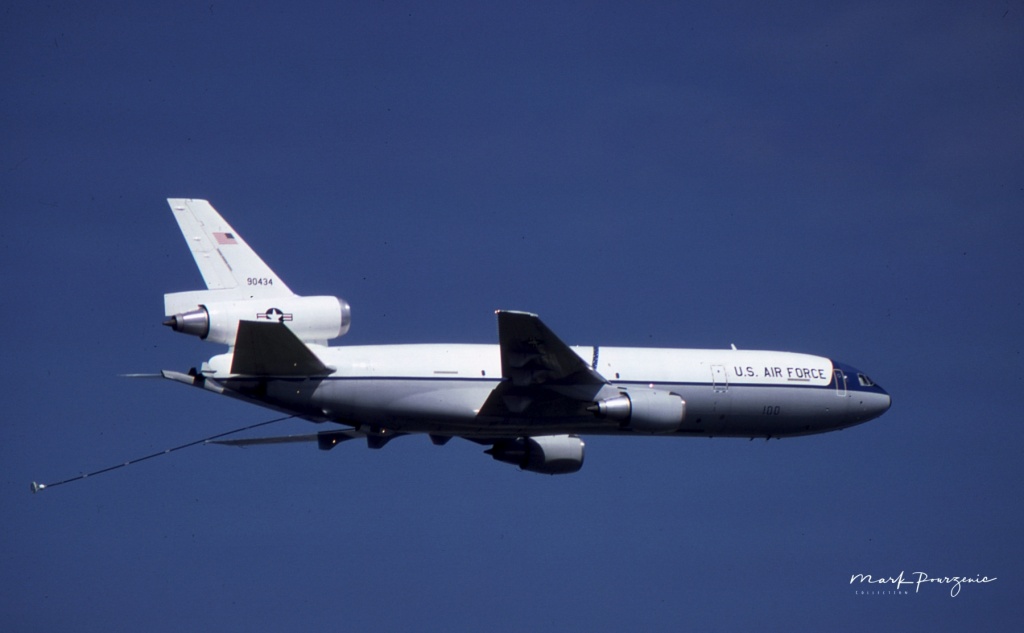
McDonnell Douglas KC-10A Extender, 79-0434 with its drogue hose extended, in its original Strategic Air Command scheme of white, gray and blue. Of note-Strategic Air Command (SAC) sash across center fuselage.
The 60th Operations Group located at Travis AFB has four flying Squadrons under their care – the 21st Airlift Squadron that fly the Boeing C-17A Globemaster III, the 22nd Airlift Squadron that fly the Lockheed C-5M Super Galaxy, and the 6th and 9th Air Refueling Squadrons that operate the McDonnell Douglas KC-10A Extender.
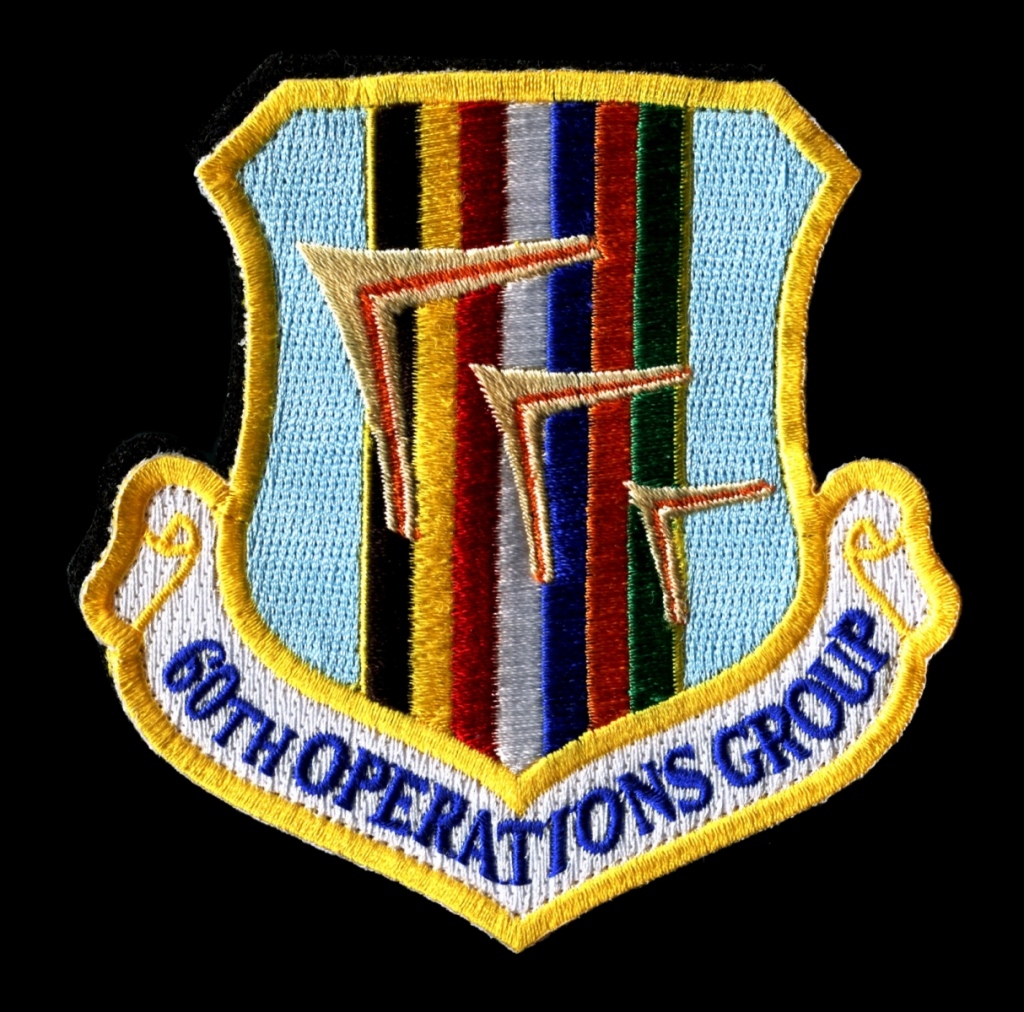
60th Operations Group embroidered patch.
The 60thAMW can trace its lineage back to July 1948 at Kaufbeuren Air Base in occupied Germany with the establishment of the 60th Troop Carrier Wing (60thTCW). During 1949 the 60thTCW was relocated to RAF Fassberg in Germany and as a result, was involved in the Berlin Airlift at the time operating Douglas C-54 Skymasters and C-47 Dakotas.
After the Berlin Airlift, the 60thTCW relocated to Wiesbaden Air Base in West Germany under the command of the Twelfth Air Force, as part of United States Air Forces Europe. The 60thTCW was inactivated in September 1958, with it reactivating in December 1965, and relocating to its current home at Travis Air Force Base, California during January 1966, under the newly formed Military Airlift Command (MAC).
Equipped with the C-124 Globemaster II, the C-130 Hercules, the C-141 Starlifter and C-133 Cargomaster plus the C-5 Galaxy, the 60th Military Airlift Wing (60thMAW) had itself a large fleet of cargo aircraft to assist with any contingency and soon found itself involved with the conflict in South East Asia.

60th Air Mobility Wing embroidered patch.
Over the years, the 60thMAW has supported Israel during the 1973 Yom Kippur War with Operation NICKEL GRASS, Operation BABYLIFT during the fall of Saigon in 1975, also Operation DEEP FREEZE began in 1974 to resupply research teams in the Antarctic. Throughout the 1980’s, the 60thMAW was involved with the U.S led attempt to oppose corrupt dealings within Central America, with missions such as Operation JUST CAUSE that toppled Panamanian dictator Manuel Noriega from power.
Along with countless humanitarian missions over the years, the 60thMAW have assisted countless communities with disaster relief flights, bringing with them aid and supplies, as was the case with Mexico City’s devastating earthquake in 1985, and the evacuation of Clark Air Base in the Phillippines during 1991 after the volcano Mount Pinatubo erupted.

McDonnell Douglas KC-10A Extender, 83-0078 seen here at Melbourne International Airport during the United States Air Force Demonstration Team ‘The Thunderbirds’ Australian visit during 1987. This same aircraft was noted at the 2011 Australian International Airshow in the gray scheme as adopted by AMC, supporting the USAF’s first deployment of its F-22A Raptor aircraft to an Australian airshow.
With the end of the Cold War and the restructuring of the United States Air Force, the 60thMAW was redesignated the 60th Airlift Wing on November 1st 1991, under the newly formed Air Mobility Command (AMC), before one final change on October 1 1994 that saw the 60thAW redesignated to the 60th Air Mobility Wing.
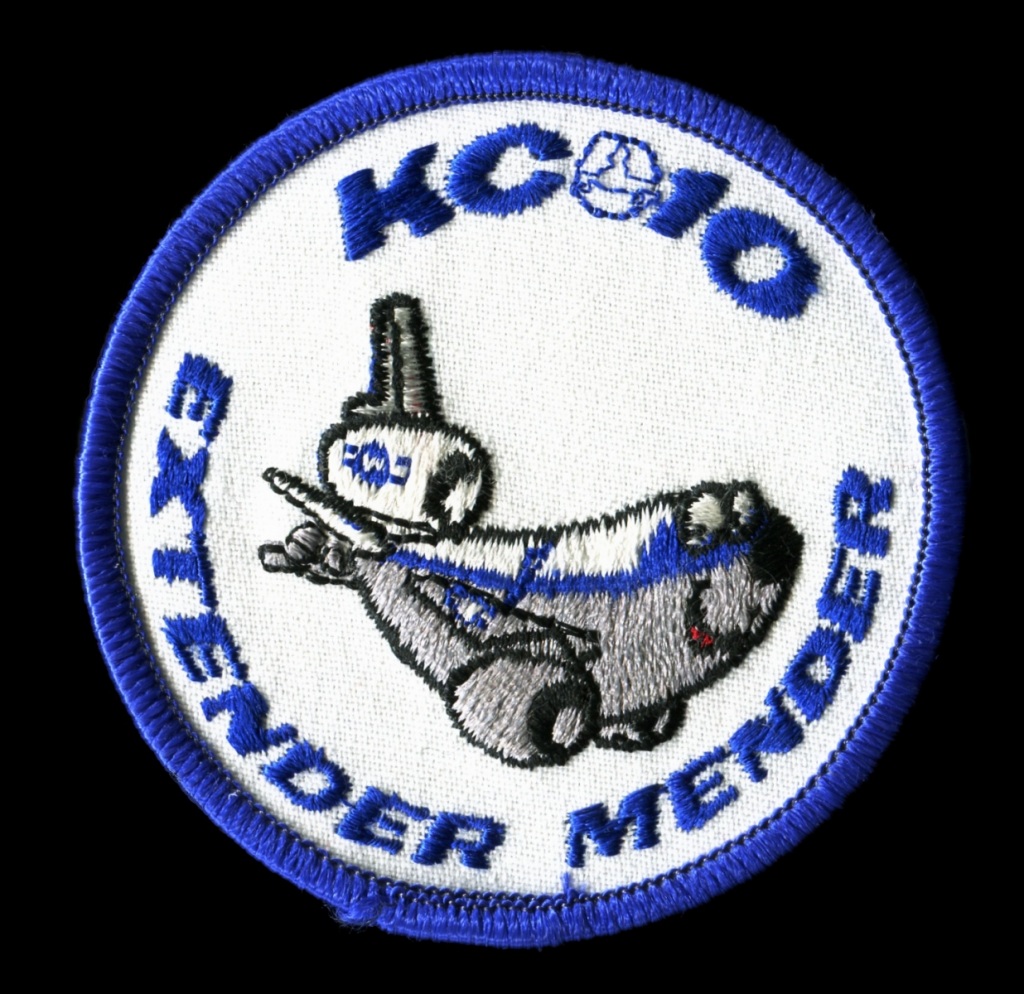
KC-10 Extender Maintenance Personnel embroidered patch.
Media Flight –
During Talisman Sabre 2019, the U.S Department of Defense offered a select number of available positions to media, on one of four media flights, onboard their McDonnell Douglas KC-10A Extender aircraft, that where participating in this years exercise. After sending through a request, I was delighted to receive confirmation and that my flight would take place on Wednesday July 24 2019, departing Brisbane Airport, Queensland.
With instructions from the USAF Public Affairs Officer to be present at the designated location, that being Jet Aviation, who are situated at Brisbane Airport at 7:30am sharp. I duly booked my flights, and was airborne on the Tuesday evening prior, with Virgin Australia flight VA353, departing Melbourne Airport for Brisbane, a mere 2 hour, 10 minute journey away.

Looking through the rain stained glass as my aircraft approaches the gate for boarding to Brisbane. Virgin Australia Boeing 737-8FE, VH-VOL seen during a typical Melbourne winters evening.
Arriving at Jet Aviation early Wednesday morning, I made myself known to my fellow peers who I would be sharing this incredible experience with. It wasn’t too long after arriving that the USAF Public Affairs Officer (PAO) arrived, and began to give us a short safety brief on what to expect during our time in the air. With our crew for the flight also arriving, the excitement was starting to build as it wasn’t long before we were on the bus, and headed to our aircraft which were parked on the opposite side of the airport.
Once arriving at the aircraft, we where given a few minutes to grab some imagery, before making our way up the air stairs and making ourselves comfortable, whilst also meeting with the crew and so forth. After 20 minutes, the boom operator gave us a quick safety brief in regards to exiting the aircraft in case of an emergency, and at this time, the crew where beginning their pre-flight checks for the engine start up procedure. I was offered the jump seat for the take-off roll, unfortunately there was a problem with the seat belts, which meant it wasn’t possible to be seated there as per the strict requirements regarding being strapped in during take-off/landing and refueling.
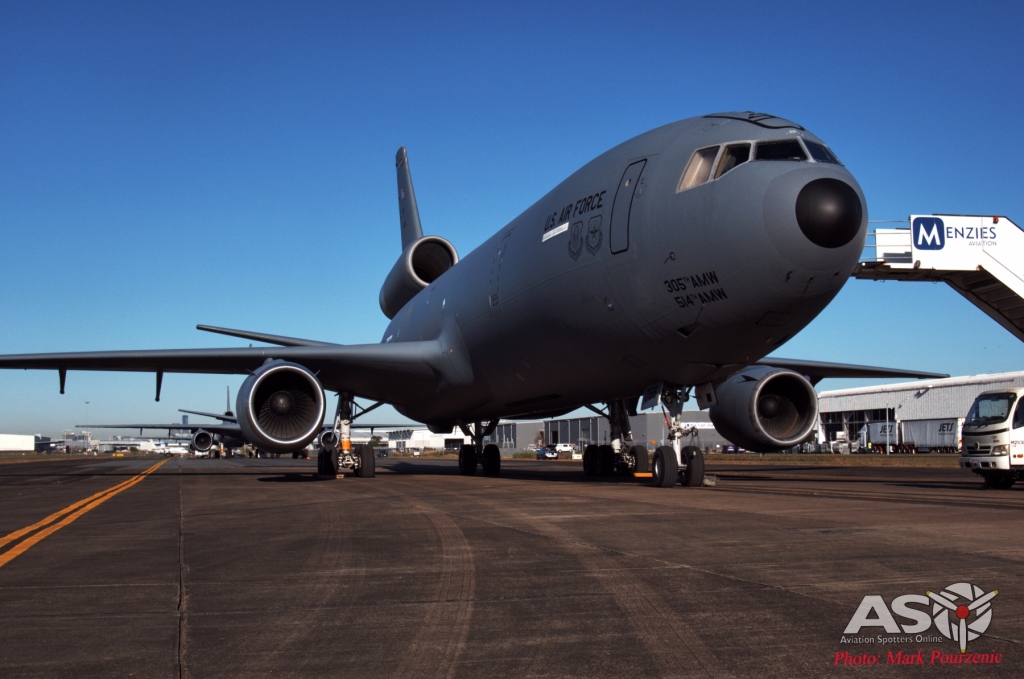
MDD KC-10A 84-0188, our aircraft for the media flight.
With our crew of four, including an USAF observer, who by the way is a B-52 pilot with the 69th Bomb Squadron, our PAO, and 5 media, we where set to taxi to our holding position before take-off. With our aircraft full of fuel, one couldn’t help but notice that when taxiing along, it felt like every bump was magnified more than what I’ve felt in other aircraft. Whilst at the threshold and awaiting take-off clearance, the excitement was starting to build. With the crew leaving the cockpit door open for all to have a glimpse into their world for the entire flight, it was interesting to see just how relaxed and collected they where, which brought about a calmness to all onboard.

The 6thARS crew hard at work during our flight.
With the sound of the three General Electric CF6-50 turbofans spooling up to get the KC-10 lined up on the runways centreline, one couldn’t help but feel like the show is about to start, and with that, the unmistakable howl of the KC-10’s engines reverberated throughout the aircraft as we started our take-off roll down Brisbane Airports main runway.
Once we reached our intended safe altitude, the seat belt sign was turned off, and we were free to move about the forward cabin area, including the cockpit. Once again, having the privilege to step into a working cockpit whilst airborne is an amazing experience, and certainly a memory that will stay long after the flight is over. As there were five of us media onboard, we where split into three groups that would have the opportunity to sit alongside the boomer whilst aerial refueling was taking place.
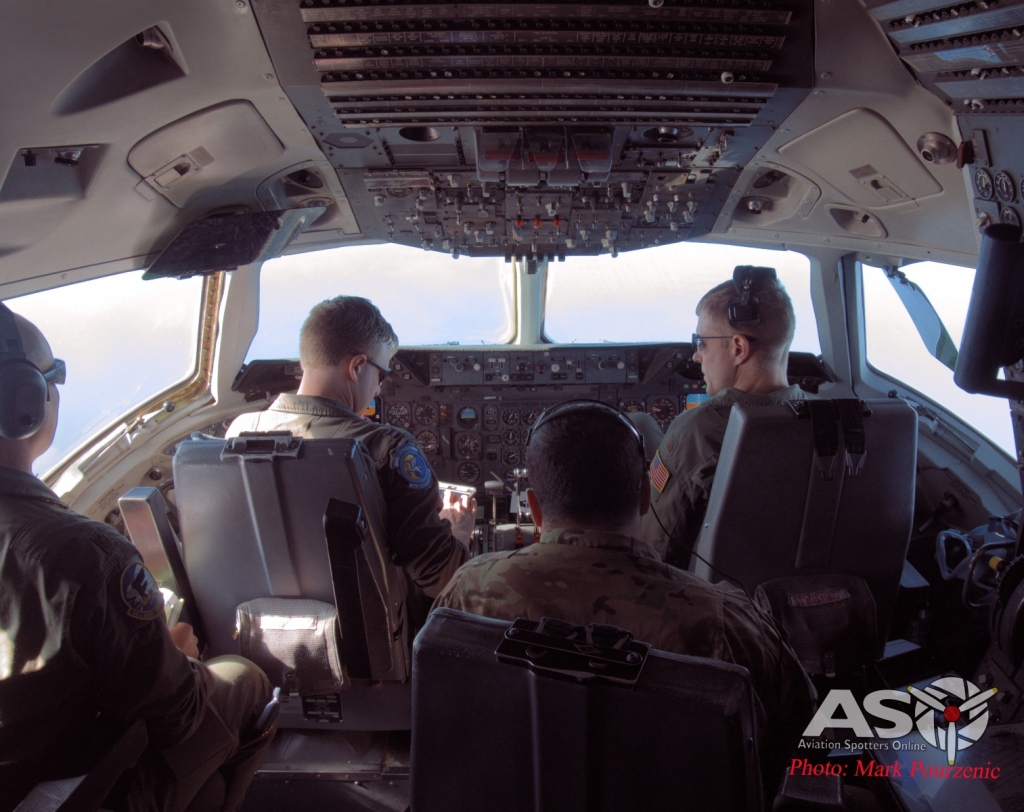
No time to relax as this 6thARS crew is hard at work getting their ’10’ on station to fulfill the motto of the 60thAMW – ‘Americas First Choice’.
Once our aircraft reached its holding area, we began to fly in a racetrack pattern, which basically means that the receiving aircraft know of our position within this area, and will fly within the same pattern when coming up from behind to receive fuel. As the first group of receiving aircraft arrived, the go ahead was given by the PAO for the first nominated pair to head down to the rear of the aircraft, who fortunately where able to catch the Lockheed Martin F-22A Raptors from the 90th Fighter Squadron taking on fuel. (One thing to mention is that during refueling, all passengers and crew must be seated and seat belts worn, in case of an emergency where the aircraft need to separate quickly). After 10 or so minutes, they returned with the second pair heading down the rear, who again caught the remaining pair of 90thFS F-22A Raptors, including a pair of U.S Navy F/A-18E Super Hornets.

Flight Engineers station onboard the KC-10A Extender. Watching him during the flight, he was constantly monitoring the fuel flow and adjusting accordingly.
With the second group down the rear a touch longer due to the Super Hornets taking longer to tank via the hose, my anticipation was at its peak, as not knowing what to expect was exciting. Finally, I was given the okay to walk down the rear of the aircraft, firstly through the gap through the environmental curtain that separates the cargo hold with the forward crew area, and into the expanse of the cargo hold, where you walk along a gangway to the extreme left of the aircraft, with a safety rope attached to hang onto in case of turbulence.

KC-10A Extender Safety Card.
Making my way down the stairwell, which takes me below decks to the boomers compartment, I’m greeted by the boom operator who motions me to take the seat to his right, and hands me a pair of headphones so you can listen in on the radio transmissions between the pilots of both aircraft. Looking through the window, I’m directed to look up, as when the receiving aircraft is on the hose, which in our case, a U.S Navy Boeing F/A-18E Super Hornet from VFA-27 ‘Royal Maces’, that belongs to Carrier Air Wing 5 (CVW5), operating off the aircraft carrier, USS Ronald Reagan, they tend to fly behind the tanker, rather than below it, as opposed to tanking off the boom.
So here I am, video camera in hand, watching a Super Hornet only metres in front of me, over the Pacific Ocean, onboard a USAF KC-10 taking on fuel. To say it was surreal would be an understatement. As this amazing spectacle in front of me unfolds,I have the time to chat with the boomer quickly, and also capture a few images with my still camera. The boomer then announces over the intercom theres less than a minute remaining until its time for the Super Hornet to disengage. As he drops off and banks away, within seconds, a second VFA-27 F/A-18E is seen approaching the rear of the KC-10 ready to ‘plug in’ to the hose. Seeing first hand the incredible skill required to undertake such feats is truly awe inspiring, and again, feeling very humbled in being able to witness this first hand.
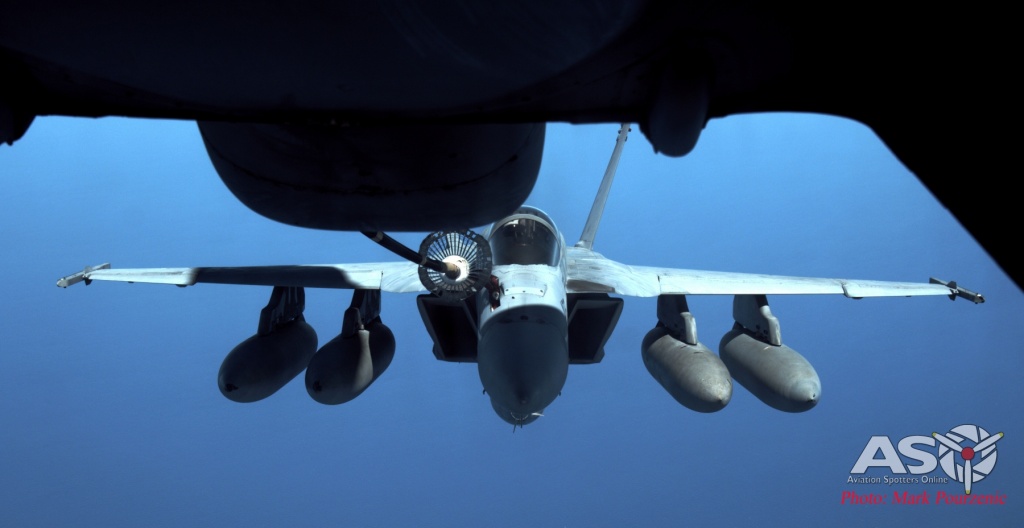
Up close and personal with an F/A-18E Super Hornet, BuNo-166903 NF-402 from VFA-27 ‘Royal Maces’ during Talisman Sabre 2019.
After watching the second receiver unplug and depart, myself and fellow peer decided it was time to give the next group a shot, and headed back up to the forward crew area, where we heard some very exciting news. Our flight coincided with the final day of air operations during Talisman Sabre 2019, and it turned out that our fellow KC-10 crew that departed after us earlier in the morning, had failed to offload a safe amount of fuel due to a lack of receivers, that would necessitate its safe arrival and landing back at Brisbane Airport. We were advised that before long, we would rendezvous with the other KC-10A, via mid-air, aerial refueling, to take on enough fuel which would allow it to perform the rest of its mission profile safely.

Although our crew was from the 6thARS/60thAMW, our KC-10A Extender for the flight, is a McGuire based bird that has been utilized by Air Mobility Command to carry out its mission of Global Reach. This banner hangs inside the forward crew compartment.
As the final group and boomer arrived back in the forward crew compartment, there was a certain buzz in the air, as all onboard understood the enormity of what was about to unfold before our eyes. Looking through the cockpit, we could see the second KC-10A Extender in front of us, tanking a pair of Super Hornets as we slowly flew up behind, before it was time to commence the in-flight refueling procedure. As with all tanking operations, the seat belt sign was lit up, and all passengers had to take their seated positions. I was luckily seated behind the cockpit, and whilst the view was slightly obstructed, watching the windscreen fill with the view of another KC-10 is something one must experience first hand, as being in such close proximity to another widebody aircraft is truly amazing. One thing that will stay in my memory bank is the audible ‘thump’ of the refueling receptacle mating with our KC-10A high above the Pacific Ocean, and the relative calm of the crew flying in such tight quarters. Once we had taken on almost 91,000kg of fuel in a matter of minutes, we could see the second KC-10 flying away from our position which seemed like nothing had happened at all.

F/A-18E Super Hornet BuNo-168369, NF-207 from VFA-27 ‘Royal Maces’ operating from CVW-5 – USS Ronald Reagan.
After we were topped up, we started our flightpath back to the Australian coast, and setting ourselves up for our return to Brisbane Airport. After a few discussions, I was once again afforded the rare opportunity to be in the cockpit, to experience first hand, whilst in the observers seat to the left, and behind of the aircraft captain, our approach and landing. Extremely happy and honoured are two words I’ll use for this privileged moment I was able to experience, and with the forthcoming vision, you’ll understand why. Having the opportunity to film our flight along the eastern coast of Australia as we made our way up to Brisbane was an unbelievable experience. I’d like to stop talking about my flight and allow you, the viewer, to watch what I tried to capture of this amazing life moment I was able to experience, and am more than happy to be able to share this experience with you.
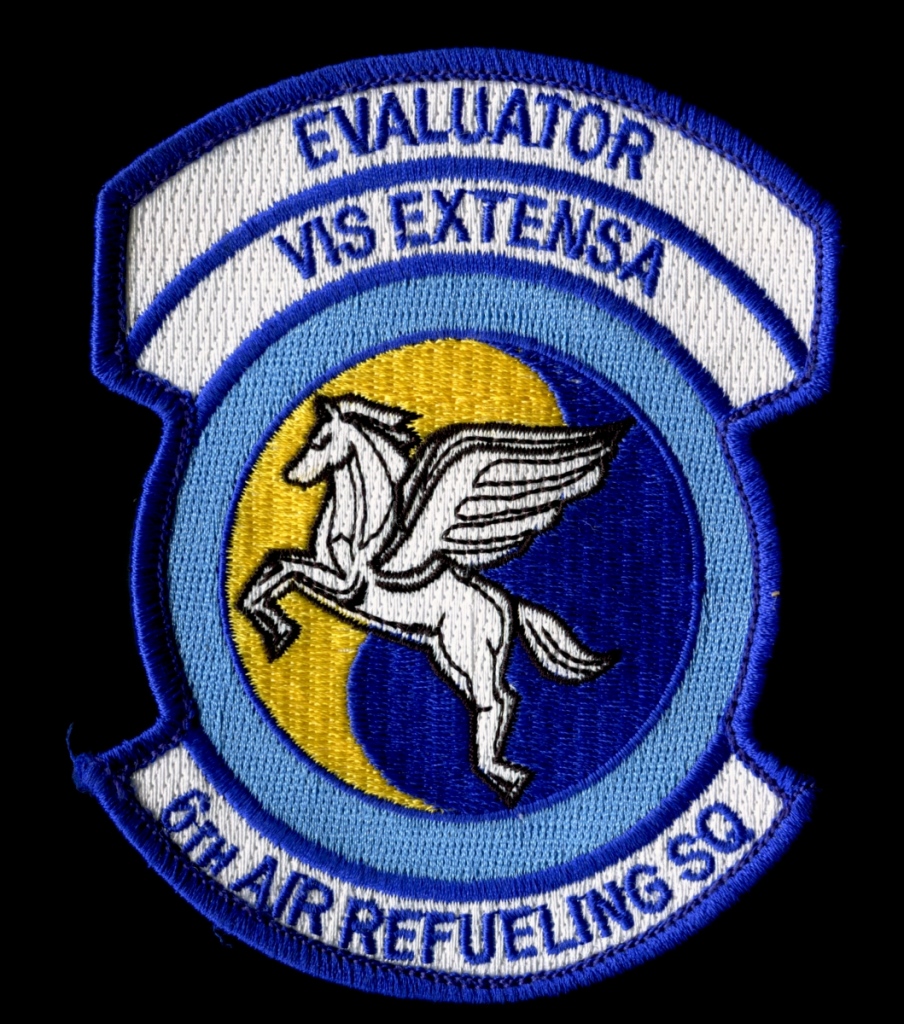
As worn by the flight crew during our media flight. 6thARS Evaluator embroidered patch, a very special gift and will be a treasured patch in my collection.
Aviation Spotters Online would like to take this opportunity to gratefully thank, in no particular order – Royal Australian Air Force Public Affairs, the Australian Department of Defence Media team, the United States Air Force Public Affairs Office and Associated Team Members ( Maj. A” Glacier” Blue and 2nd Lt.S.Thrift ), the 6th Air Refueling Squadron, the 60th Air Mobility Wing, United States Air Force, Pacific Air Force, Talisman Sabre, Jet Aviation and Brisbane Airport, for their assistance and invitation, to help with the opportunity in being able to create this article and associated vision.
Thank you
Mark Pourzenic
Aviation Spotters Online.

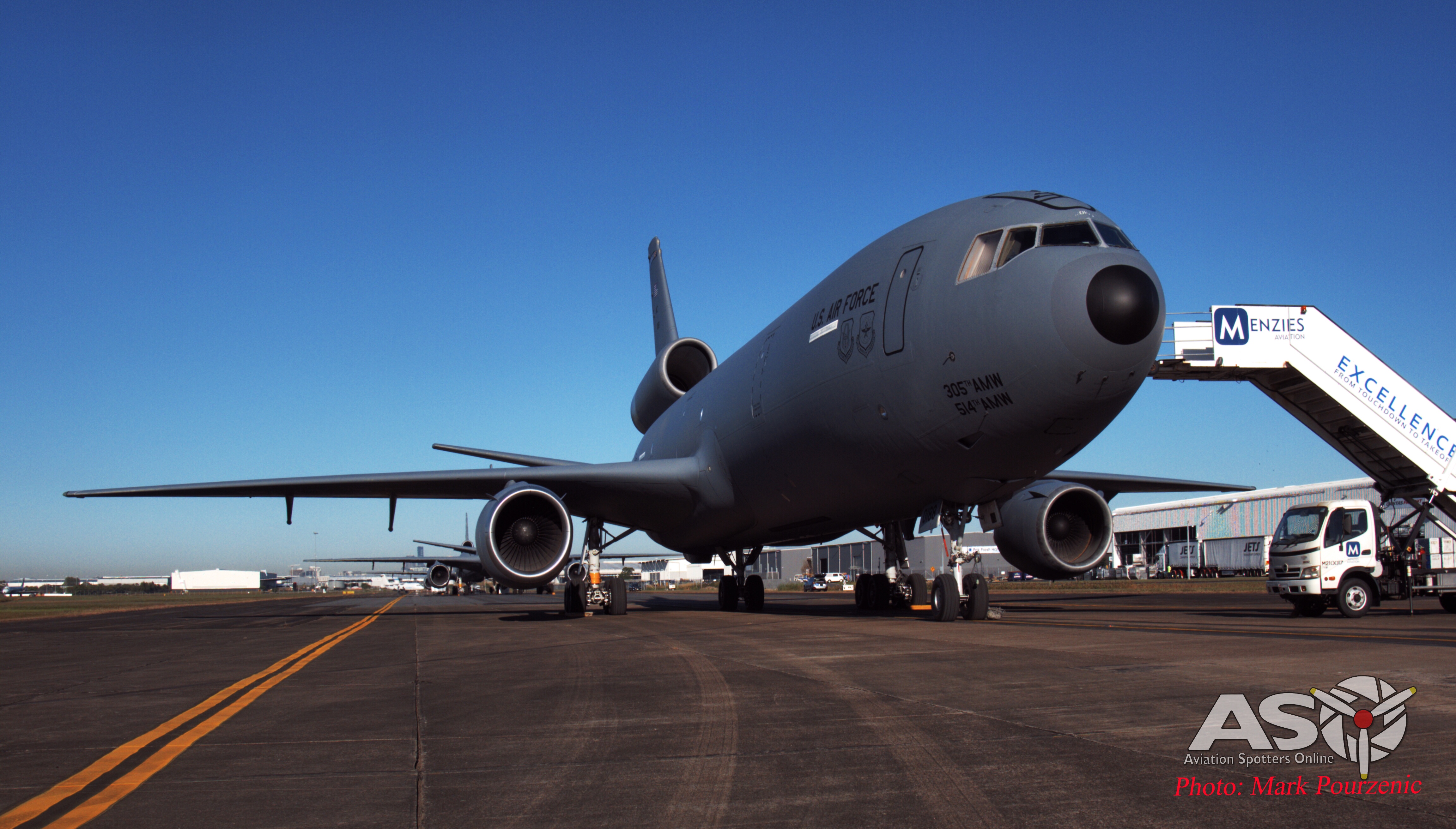

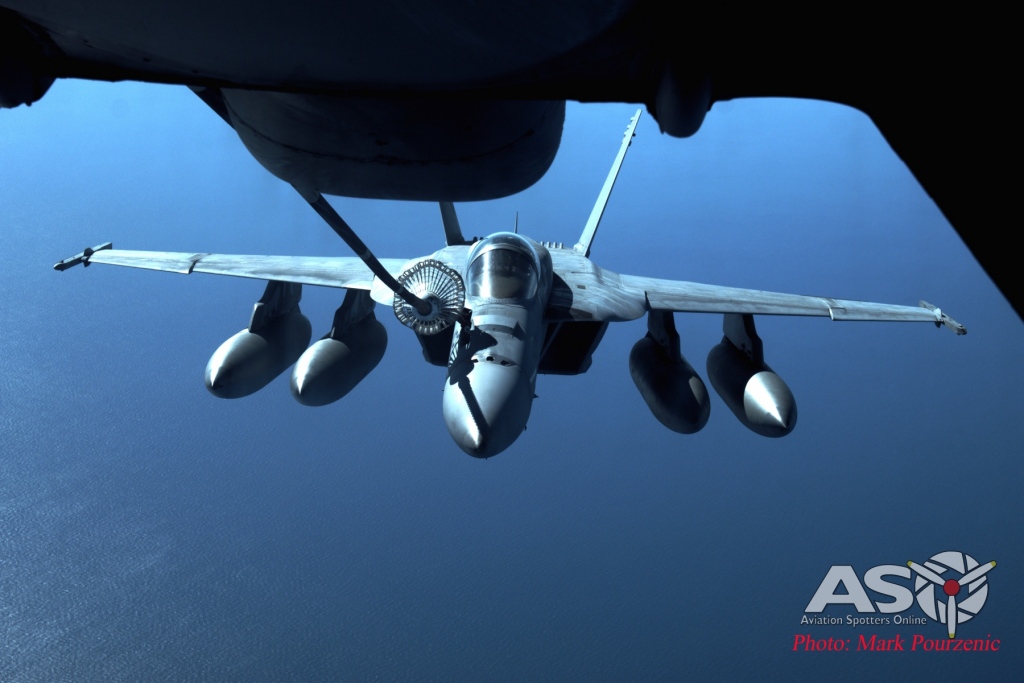

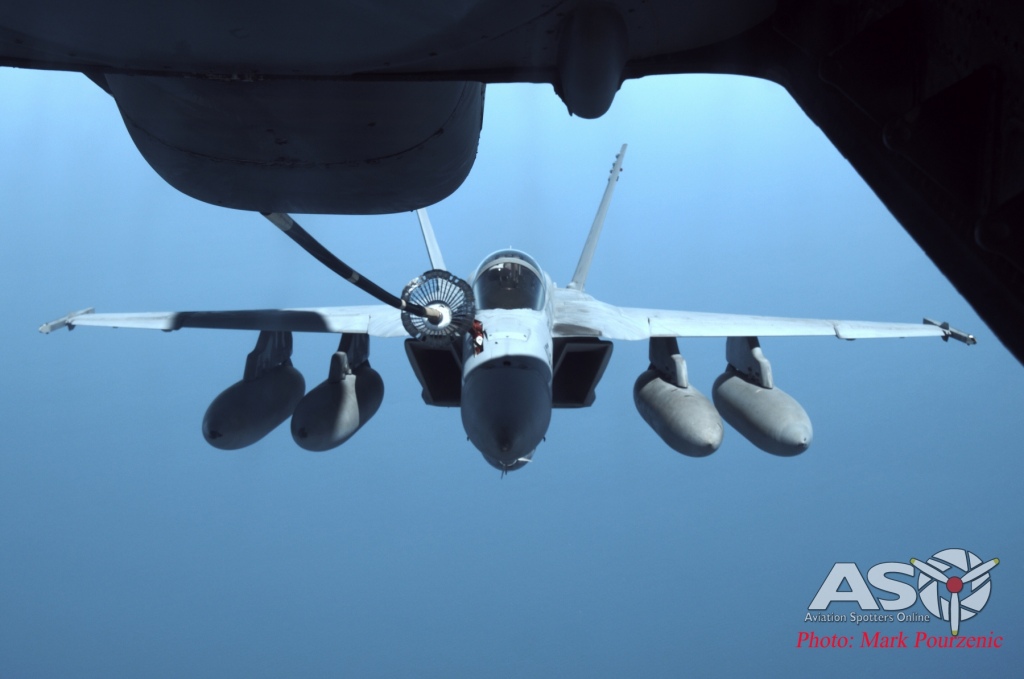



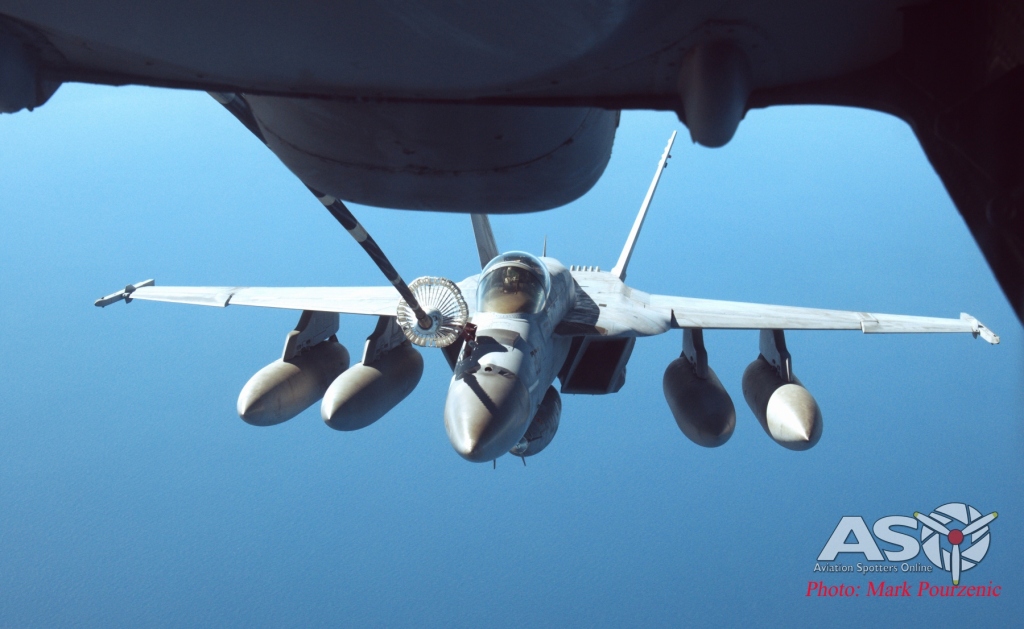




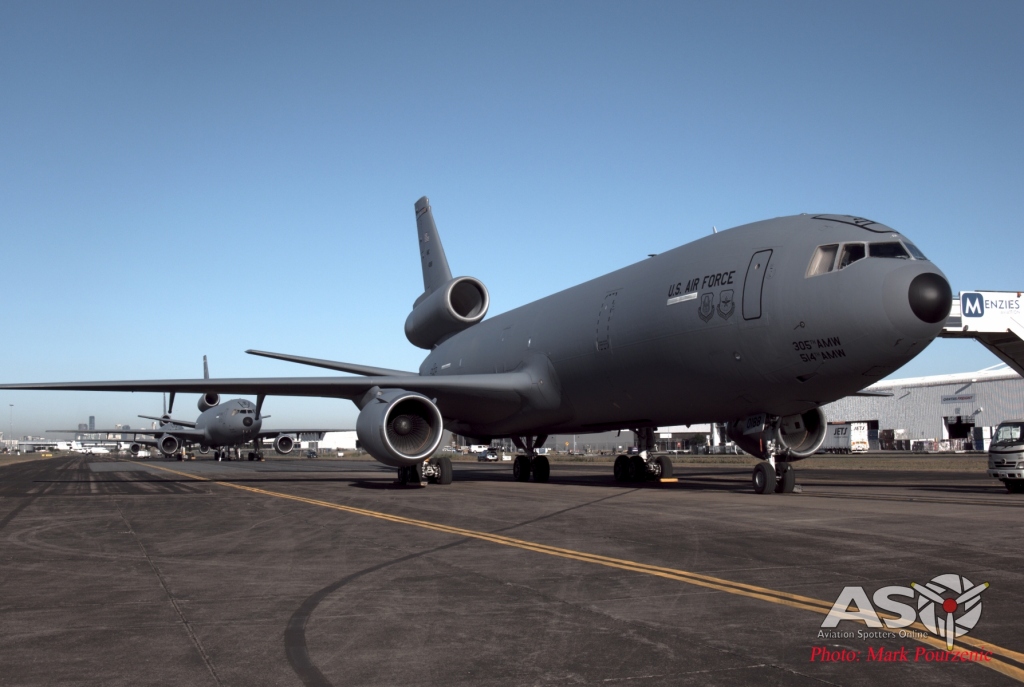









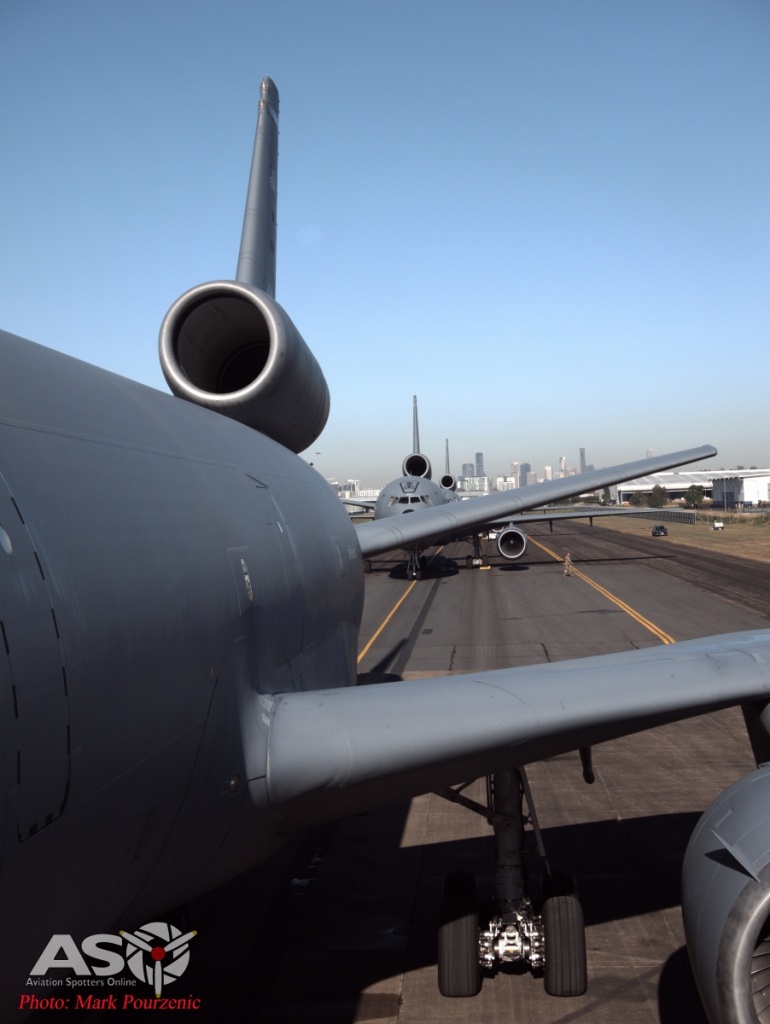
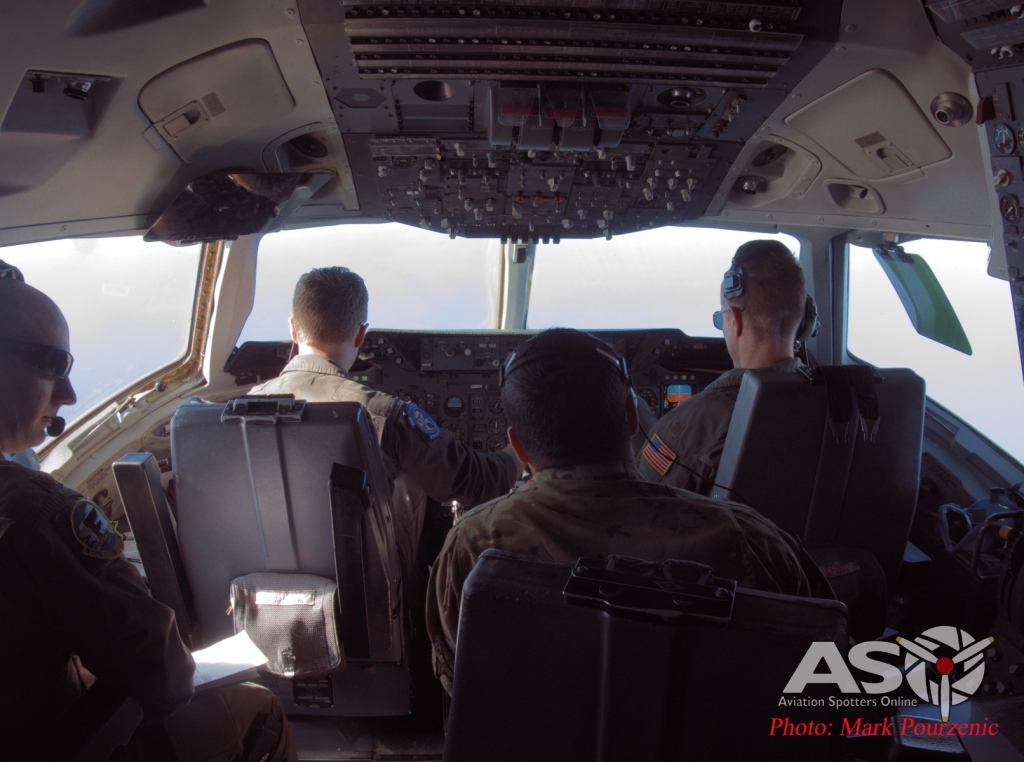






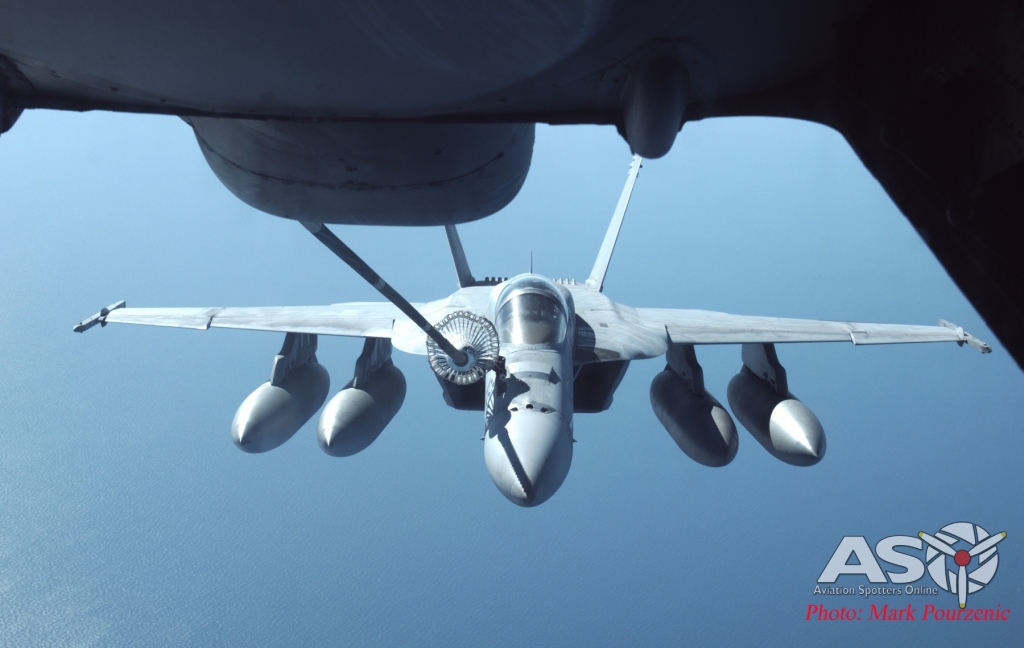



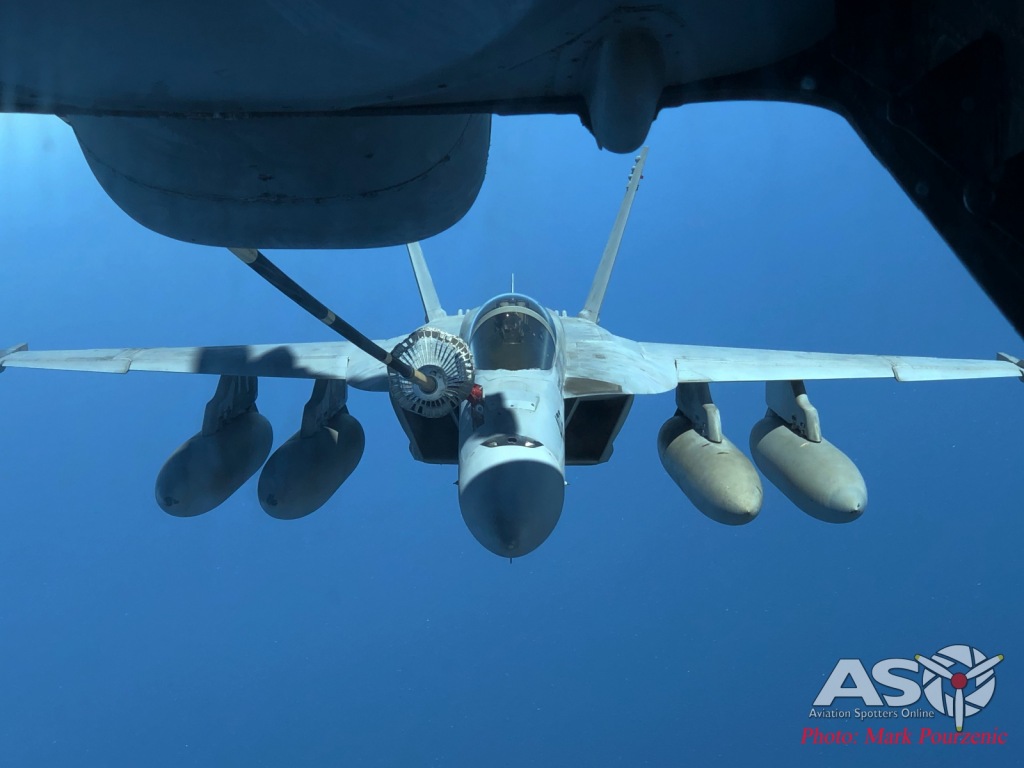















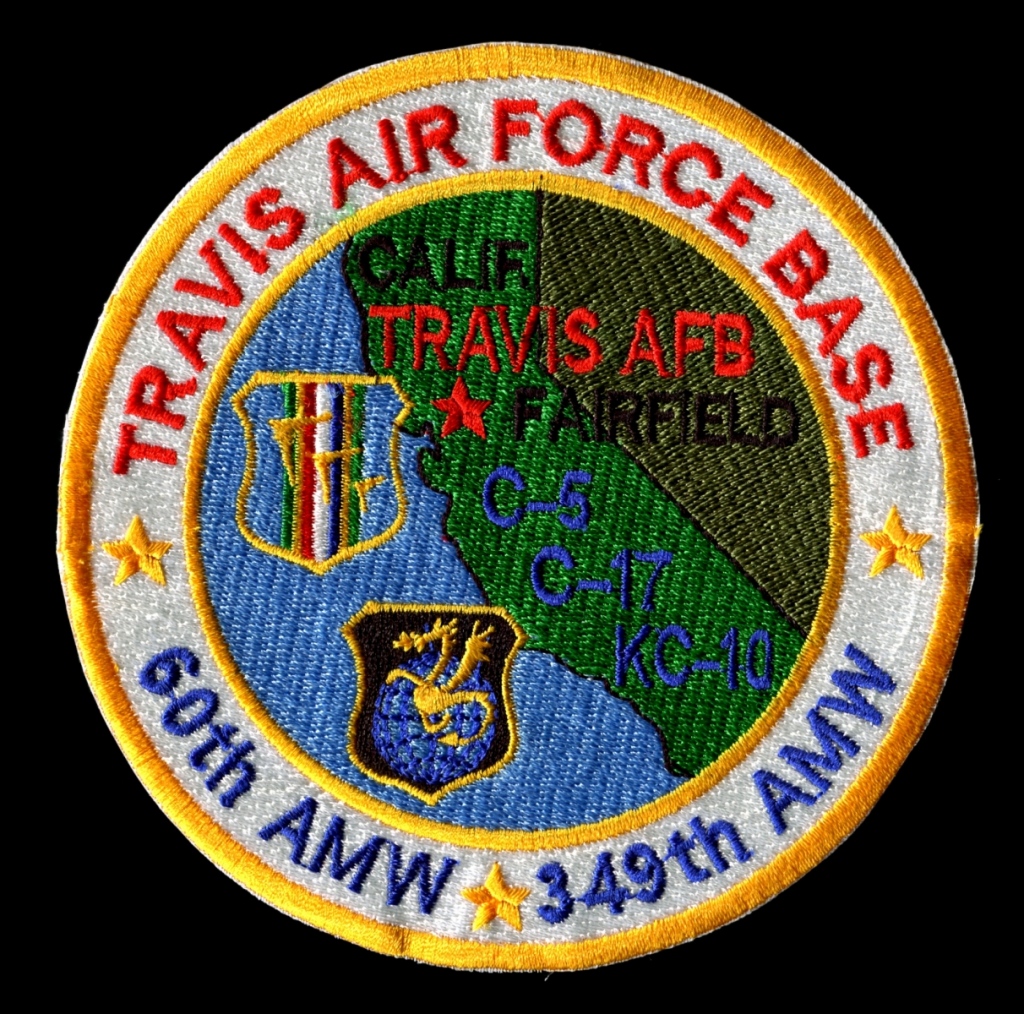

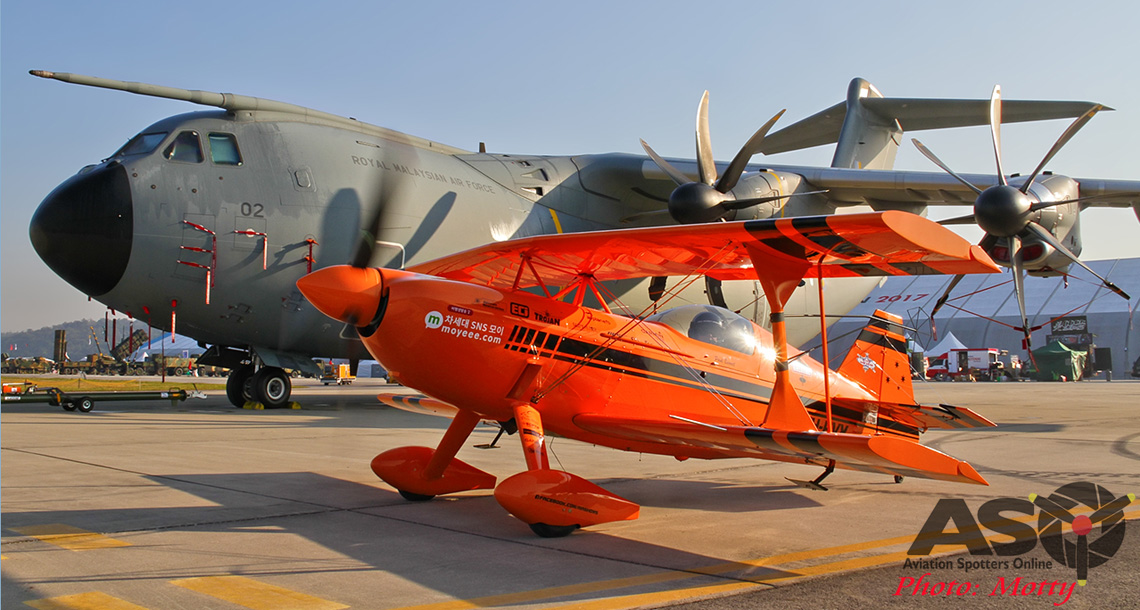

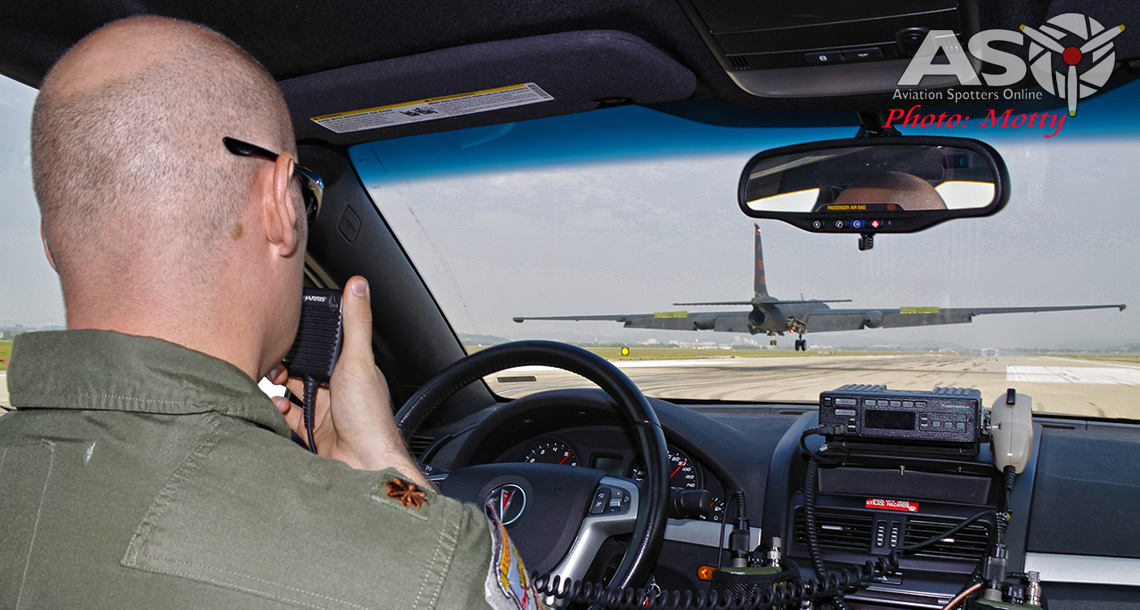





Just read your article Mark, great images and a wonderful read mate, well done. Pleased I could help you out.
Hi Peter, glad you’ve enjoyed the article, and once again, thank you for your help.
Mark Pourzenic.